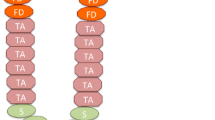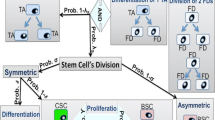Abstract
Current understanding of the pattern of proliferation within intestinal crypts involves the notion of a cutoff region introduced by Cairnieet al. (Exp. Cell. Res. 39, 539–553, 1965b). (Cells produced above the cutoff are non-cycling, whereas cells produced below the cutoff are cycling.) They contrasted the predicted distribution of proliferation in the extreme cases of a cutoff of width 0 (a sharp cutoff) with one eight cells wide (a slow cutoff) and concluded that the data were better explained by the latter. We have shown that crypt size variation artificially broadens the apparent distribution of proliferating cells in the crypt (Totafurnoet al., Biophys. J. 54, 845–858, 1988). Here we show that the measurement and analysis of crypts of a specified height reduces this artifact. This work introduces the use of distance from the crypt base (in microns) to specify the location of cells within the crypt as an improvement over the cell position ordering traditionally used in the determination of the distribution of proliferating cells. We also show how to explicitly correct for several artifacts in the measurement of the labelling index. We conclude that cell proliferation within the crypt is more localized than previously realized; in fact, a cutoff as slow as eight cells wide is rejected.
Similar content being viewed by others
Literature
Al-Dewachi, H. S., N. A. Wright, D. R. Appleton and A. J. Watson. 1975. Cell population kinetics in the mouse jejunal crypt.Virchows Archiv. Cell Path. 18, 225–242.
Bjerknes, M. and H. Cheng. 1981. The stem cell zone of the small intestinal epithelium. I. Evidence from the Paneth cells in the adult mouse.Am. J. Anat. 160, 51–63.
Burholt, D. R., B. Schultze and W. Maurer. 1976. Mode of growth of the jejunal crypt cells of the rat: an autoradiographic study using double labelling with3H-and14C-thymidine in lower and upper parts of crypts.Cell Tissue Kinet.9, 107–117.
Cairnie, A. B., L. F. Lamerton and G. G. Steel. 1965a. Cell proliferation studies in the intestinal epithelium of the rat. I. Determination of the kinetic parameters.Exp. Cell. Res. 39, 528–538.
Cairnie, A. B., L. F. Lamerton and G. G. Steel. 1965b. Cell proliferation studies in the intestinal epithelium of the rat.II. Theoretical aspects.Exp. Cell. Res. 39, 539–553.
Cheng, H. and C. P. Leblond. 1974. Origin, differentiation, and renewal of the four main epithelial cell types in the mouse small intestine. I. Columnar cell.Am. J. Anat. 141, 461–480.
Cheng, H. and M. Bjerknes. 1982. Whole population cell kinetics of mouse duodenal, jejunal, ileal, and colonic epithelia as determined by radioautography and flow cytometry.Anat. Rec. 203, 251–264.
Fraser, D. A. S. 1976.Probability and Statistics: Theory and Applications. North Scituate, MA: Duxbury Press.
Frodesen, A. G., O. Skjeggestad and H. Tøfte. 1979.Probability and Statistics in Particle Physics. Irvington-on-Hudson, New York: Columbia University Press.
Kalbfleisch, J. G. 1985.Probability and Statistical Inference, Vol. 1, 2nd edn. New York: Springer-Verlag.
Kovacs, L. and C. S. Potten. 1973. An estimation of proliferative population size in stomach, jejunum, and colon of DBA-2 mice.Cell Tissue Kinet. 6, 125–134.
Lloyd, E. 1984.Handbook of Applicable Mathematics, Vol. VI, part A. Toronto: John Wiley & Sons.
Mood, A. M., F. A. Graybill and D. C. Boes. 1974.Introduction to the Theory of Statistics, 3rd edn. New York: McGraw-Hill Book Co.
Quastler, H. and F. G. Sherman. 1959. Cell population kinetics in the intestinal epithelium of the mouse.Exp. Cell. Res. 17, 420–438.
Schultze, B., V. Haack, A. C. Schmmer and W. Maurer. 1972. Autoradiographic investigation on the cell kinetics of crypt epithelia in the jejunum of the mouse.Cell Tissue Kinet.5, 131–145.
Schultze, B., A. M. Kellerer and W. Maurer. 1979. Transit times through the cycle phases of jejunal crypt cells of the mouse. Analysis in terms of the mean values and the variances.Cell Tissue Kinet.12, 347–359.
Totafurno, J., M. Bjerknes and H. Cheng. 1987. The crypt cycle: crypt and villus production in the adult intestinal epithelium.Biophys J.52, 279–294.
Totafurno, J., M. Bjerknes and H. Cheng. 1988. Variation in crypt size and its influence on the analysis of epithelial cell proliferation in the intestinal crypt.Biophys J. 54, 845–858.
Wright, N. and M. Alison. 1984.The Biology of Epithelial Cell Populations, Vol. 2. Oxford, England: Clarendon Press.
Author information
Authors and Affiliations
Rights and permissions
About this article
Cite this article
Totafurno, J., Bjerknes, M. & Cheng, H. Estimation of the extent of the cutoff region from the spatial distribution of labelling and mitotic indices of intestinal crypts of a fixed length. Bltn Mathcal Biology 55, 37–73 (1993). https://doi.org/10.1007/BF02460294
Received:
Revised:
Issue Date:
DOI: https://doi.org/10.1007/BF02460294




